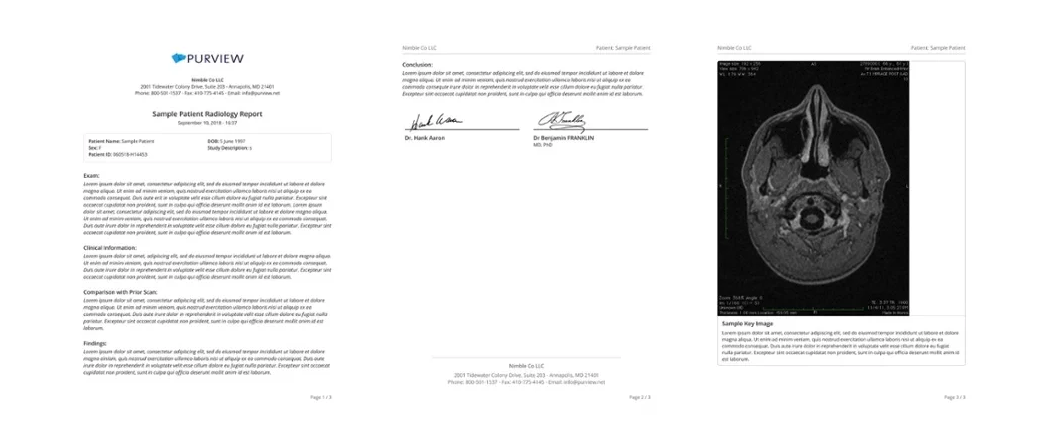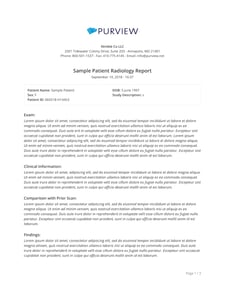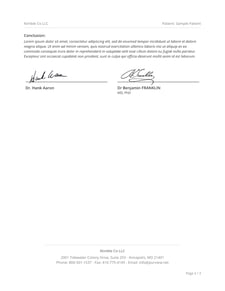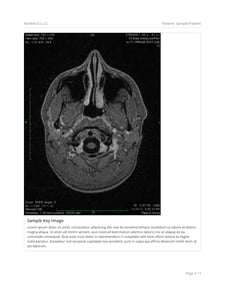Radiology Reports with Key Images Improve Communication

A standard radiology report is a useful way to capture and succinctly communicate the results of most imaging scans, including X-rays, CT scans and MRIs. Whether in human health or veterinarian care, this summary of the identified condition and diagnosis is a critical communication tool between the radiologist and the treating physician or patient. While radiology reports are traditionally comprised of text, reports with key images improve communication by providing a new layer of depth and understanding for physicians and their patients.
Whether dictated or typed, written reports were limited to word-processor-like features to make the radiologist’s job efficient. Though radiologists often craft descriptive language that paints a comprehensive picture of the diagnosis, most physicians believe that including an image in their report is extremely helpful. Reports with key images would be able to show the patient or the referring physician exactly what the radiologist saw in his or her read of the scan.
Understanding Key Images
Reports are typically generated on paper or an analogous electric rendition of a two-dimensional surface. Most medical image viewers and analysis workstations can capture these 2-D images, making them available for inclusion in a report, but the translation from the image view to the printed report is often awkward and complicated. It’s even more of a challenge when using advanced imaging modalities that generate multi-dimensional images or time-based video. Attempting to portray these types of results in the limited dimensions of a report does not convey their full effect.
Three- and four-dimensional medical image scans are actually comprised of a series of two-dimensional images, or slides. While reviewing a study comprised of multiple images, the reading radiologist is often able to identify a particular still image in the pack that shows his or her findings most effectively. This image, or set of images, are designated as being “key”. These are usually exported as standard format 2-D images like .jpeg that can be printed or displayed on a screen. It's becoming critically important to simply and efficiently identify, capture, and transfer these key images into the final radiology report. Doing so adds a much-needed richness to the recipient’s understanding of the radiologist’s findings.
Often these image slides contain annotations with measurements, descriptive text or other identifiers indicating the radiologist's findings. These captions provide the recipient of this study with descriptive details, ensuring they gain a clear understanding of the reading radiologist’s intentions. When included in the final report, these annotations increase the understanding and enhance the communication between these health care professionals and patients, ultimately improving the patient’s treatment and outcome.
Software like Horos, a free open-source DICOM medical imaging viewer for Apple computers, now enables physicians to capture the key images and annotations in a study, and produce a personalized professional report. Radiologists, for example, can easily share this comprehensive report with their referring physician and patients, either by email, via the cloud or in a traditional printed format, so the diagnostic information is now more clearly than ever communicated and easier to understand.



A sample radiology report that includes a key image shows how the visual context can help the recipient have a better understanding of the radiologist's findings.
How the Patient Benefits (or Happy Patient, Happy Practice)
As patients become more interested and involved in their own health and wellness, reports with key images are an important part of their understanding and participation. Studies have shown that the more information that is provided to the patient, the better their understanding of their treatment options and the more satisfied they become with their health care providers’ treatment. They are also more likely to return to that provider if they feel that they are kept well-informed.
Of course, it’s also not much of a surprise that in this increasingly connected social networked world, patients are becoming quite comfortable sharing their images online with friends and family. Whether they're announcing the exciting news of a baby by posting an ultrasound photo or sharing an entertaining story about how they broke their arm with a photo of the x-ray, patients can use the high-quality key images to stay connected with their loved ones on social media.
Looking Ahead
More and more, physicians find that providing electronic links between key images and the actual study is increasingly effective in improving communication. While traditional 2-D images add value to reports, providing access to view the study itself, including multiple dimension and notes from the technician who did the scan, enables the patient to better understand the radiologist's findings.
Referring physician and veterinarian portals, which allows the recipient to view the same information as the radiologist, are becoming an important step even beyond providing key images in a report summary. It has been shown that physicians are more apt to continue to refer patients to radiologists who provide this type of enhanced access. Next generation software with the ability to go beyond key images and share the entire patient study, is gaining traction in the industry.
In Summary
Everyone in the health care process, from provider to patient, benefits from reports with key images. In addition to making the report more comprehensive, key images and their annotations provide an easier way for recipients to digest and understand the provider's presentation of their patient’s condition, diagnosis and available treatment options. While physicians move towards providing hyperlink access to complete studies in the future, key images in reports remain a crucial component for improving the conversation between doctors and patients.


